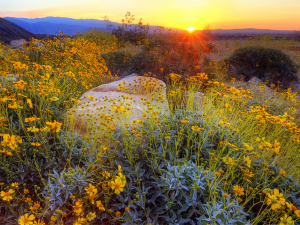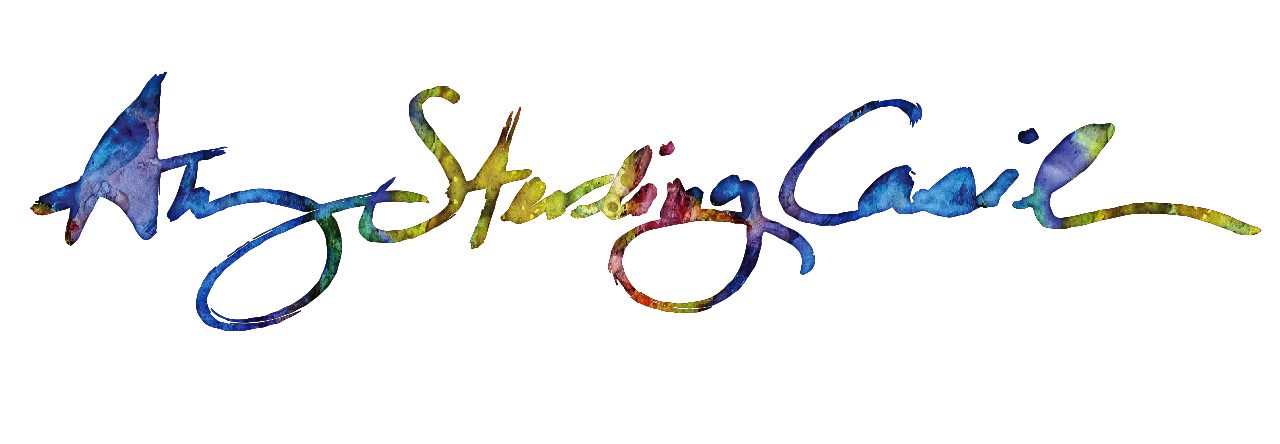
We drive over the mountains through manzanita and scrub brush. Soon the land turns to hard Mojave, with scattered cholla and endless sand and the painted badlands wrinkled like an old seaman’s weathered face. A few miles on a narrow, state-maintained road winding through red and brown shattered volcanic cliffs, and we enter the hamlet of Borrego Springs. In this desert town, everyone has an ample yard filled with small white stones, sand, cactuses, and for the extravagant, palm trees and a chain-link fence.
After more driving, we are finally at the state park at the foot of the mountains. These appear tall because they are so rugged, but in reality, they are not very tall. Indian Head peak is less than 4,000 feet in height though it towers above the low, sloping valley with the visitor center and the campground.
We park and are grateful for the water and shade of the buildings, though it is only March and nothing like the heat that comes to this place in high summer. The visitor center grounds have been manicured into a Disney desert with examples of desert plants carefully arranged. Smoke trees, tall ocotillo, and cactus. The small cactus that grows like crooked thumbs and fingers I had always thought were all the same, called cholla. There are many types of cholla marked by the gravel trail, including one with fatter fingers than usual called Teddy Bear cholla. A massive barrel cactus taller than a man stands near the entrance to the low-slung visitor center. It is proudly phallic, bending slightly to the left, the top ringed with reddish thorns.
This handsome building does not change. It is exactly as I remember it. The bronze doors have handles worked in the shape of bighorn sheep antlers, which are the namesakes of this place. In Spanish, borrego means bighorn sheep. They are beautiful animals but we will not see living ones today. They are wise to live in the mountains and do not come down on the flats.
I am excited to see the pupfish, which I remember as swimming happily in a small, reedy pool.
The pool is still there, but it has changed. Now it is brackish and filled with thick mats of ghostly gray algae and foamy yellow scum. Hordes of fat bees buzz about the fetid pool; where there are no bees, there are tadpoles and flies. The pupfish are invisible. They are either dead or hiding from the bees.
“Poor pupfish,” Bruce says. “I feel sorry for them. They have to hide or the bees will sting them.”
We sit for a time on a bench overlooking the valley. In the distance, some 30 miles, are the Laguna Mountains. It is so clear they appear much closer. Farther still are the much higher peaks of the Santa Rosa mountains near Palm Springs. This bench is sturdy and well-made. It has been donated to the center in memory of a handsome couple dressed in 40’s clothing, smiling out at the watchful camera.
Behind us, people from the Nature Center are laying out a desert feast. We are sheltered beneath a paloverde. Somewhere in the tree or ground below is a dove which cries and moans like a grieving woman – a mourning dove. I look for it, but cannot see it.
We kiss as the dove cries.
After a while, we go into the Nature Center and squeeze between narrow, lumpy concrete walls made to duplicate a box canyon in the badlands. After displays of fossils and geology and a massive plaster tortoise shell which strikes me as ideal to ride, though it’s clearly indicated as a “fossil,” we come to a display of stuffed desert animals. There’s a handsome, long-legged jackrabbit and a delicate little kit fox with a fluffy, ringed tail. A mother, father and baby bighorn sheep are the centers of the display.
A small, loud boy with a black walking stick taller than himself approaches, leaning on the rail that protects the display. His father stumbles behind him, arriving just in time for the boy to announce, “Are these extinct animals?”
The father mumbles something about them being real animals. Bruce’s eyes flash with humor.
The boy says, “Are these animals dead?” He is braying with stone-cold certainty that he knows all there is to know or ever will be.
The boy’s younger brother arrives with a similar large walking stick. He mimics his brother’s manner but clearly cannot compete in this sweepstakes for the depths of vacuity and ill manners. The father, dressed in vintage Sears Nerd, seems helpless as the two jostle madly back and forth for the best position overlooking the small display.
“See those sticks?” I say quietly to Bruce, looking toward the boys. “I’ll use them on them.” His eyes twinkle.
The center is closing and the elderly volunteer must release us with the handicapped button which opens the beautifully-cast bighorn sheep doors. We are outside only moments when the idiot boys and their father exit.
“Give me that fuckin’ stick,” Bruce says in his low Philly accent. “I’ll show you your animals.”
The boys do not hear; despite being about ten and seven years of age, it’s doubtful either has heard much besides television or video games for their entire lives.
But the father does hear. His eyes widen behind his thick-framed glasses.
“Haven’t you ever seen a fuckin’ stuffed animal?” Bruce continues. “It’s a fuckin’ stuffed animal.” His voice lowers still. “Are they alive or dead,” he adds in lazy contempt.
We know the father can hear, but he needs to hear. His children are monsters in training, soon to be extinct.
This is a stark, beautiful, hard country. We drive away to the village of the mad at the shores of the brackish Salton Sea, where nothing can live. It is not hot but the air presses down on us. We are traveling along the small of the world’s back, which feels as though it bears all of its weight, tired, ancient and brutal.
Yet even in this place, there is life, burrowing under the desert sand, nestled in a paloverde, driving in a Jeep. Like the blind, buzzing bees besetting the poor pupfish, these monstrous boys will rampage on.
If things were otherwise, I think, as we drive along the gray ribbon of desert road. If things were otherwise, I would have put a bit of the stick about and made them jump like kangaroo rats on hot rocks in August.

Leave a Reply